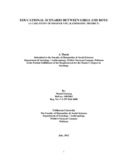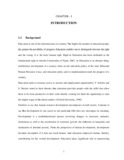Please use this identifier to cite or link to this item:
https://elibrary.tucl.edu.np/handle/123456789/2786| Title: | Educational Scenario between Girls and Boys (A Case Study of Dhapasi Vdc, Kathmandu District) |
| Authors: | Gurung, Shanti |
| Keywords: | Socio economics;Status;Enrolment |
| Issue Date: | 2012 |
| Publisher: | Department of Sociology and Anthropology, Prithivi Narayan Campus Pokhara |
| Abstract: | This is a report of a study done to fulfil partial requirement for the Master's Degree in Sociology from T U, PNC Pokhara. This study has been done in Dhapasi VDC of Kathmandu focusing on educational disparity between school going aged boys and girls. The organization and presentation of the chapters laid out in this study report is as per the format made available by the University. In this perspective, this report, in its first chapter, starts with the introduction to the concept of educational disparity and the existing situation in general in Nepalese context leading to a micro level observation of a small community. In the second chapter, some of the relevant literatures have been reviewed to diagnose the educational disparity at national and international levels. In the third chapter, the research methodology and its details adopted in this study are depicted. Following this, the fourth chapter is presented with the pictorial description of the VDC in totality supported by necessary tables and charts. The fifth chapter contains socio-economic status of the sampled area. The sixth chapter entails with the analysis on the main theme of the study, so to say, the educational disparity of the sampled area, which is followed by the conclusion and recommendation in its final chapter, chapter seven. The report refers various noteworthy factors related to the disparity concept. An increasing awareness has to be developed in the studied area on the importance of education with no gender discrimination. But surprisingly this attitude, in most of the responses, is found to be limited only up to making education available to the primary level, which, when gone beyond this level of education seems to have a considerable gender biasness. The practice of the families in the studied area, which contribute to gender biasness in education does not seem to be influenced by the general socio - economic factors, such as family background, economic status, their physical assets and possessions, castes and ethnicities, religions, languages, etc. However, when it comes to the question of selection of the schools for the boys and girls in between a private and a public school, some kind of gender biasness is seen here. Because most of the families seem to choose private schools more than the public schools for the boys compared to girls. In general, educational awareness seems to have been much increased, but the need and importance of starting education to children on time has not yet been conceived well by the people in the studied area. The report shows this fact with the evidence of having children not enrolled in schools at their Proper age. There are many children who are enrolled either below or above the age specific to a grade recommended by The Government of Nepal. The children enrolled above the appropriate age i.e., overage children are more in schools compared to the children who are enrolled below the appropriate age i.e., underage. And this fact is truer with the girls, which is a strong sign of gender biasness as well. In the studied area, in general it is also found that once the children are in the education system, girls seem to be more stable in schools compared to the boys owing to the fact that the boys have more dropouts from the school system. The major reason for the boys' dropout is related to financial factors. And the prominent reason for any cases of girls' dropout found in the studied area is because of their early marriage. With all these possible in depth observation of the educational circumstances in the studied area, the researcher has come to the concluding point that there is a great need of educational awareness programmes. The awareness programmes in the studied area require focusing on the need and importance of imparting education to the children on time and continuing it irrespective of the gender. Awareness programmes also need to be emphasized in bringing the change in the attitude of the people in the studied area in making conductive environment for the children, which is the key in reducing gender disparity. |
| URI: | http://elibrary.tucl.edu.np/handle/123456789/2786 |
| Appears in Collections: | Sociology |
Files in This Item:
| File | Description | Size | Format | |
|---|---|---|---|---|
| Cover.pdf | 56.24 kB | Adobe PDF |  View/Open | |
| Chapter.pdf | 427.92 kB | Adobe PDF |  View/Open |
Items in DSpace are protected by copyright, with all rights reserved, unless otherwise indicated.
